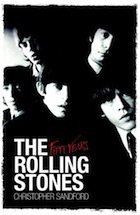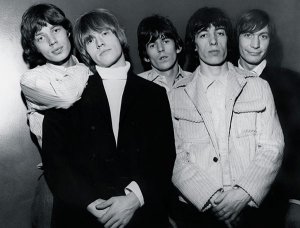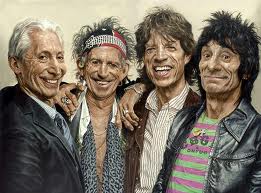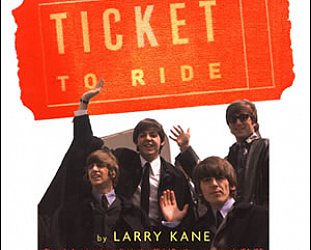Graham Reid | | 3 min read

Reading this well paced and page-turning overview of the Rolling Stones' career, lives and finances, the surprise is not that they have survived 50 years, but that they survived 1968, 1969, 1970, 1971, 1972 . . .
For more than a decade from the mid Sixties the Stones diced with death and self destruction, and yet out of that crucible of chaos at concerts, condemnation, drug busts, deaths and increasing alienation from each other, they made some of the finest, most dangerous and undeniably memorable music of their generation.
It is that music -- and, remarkably, four out of the five original band members still being alive -- which has sustained their mythology and career. The notion of "the Stones" continues in their absence. And they have been extraordinarily absent in the past couple of decades, only reforming when the money jangled in front of them has been so obscenely excessive they could hardly walk away.
By Sanford's account, when promoter Michael Cohl and their manager Prince Rupert Lowenstein cut a deal for their 1981 tour -- at a time when Jagger and Richards had been going their separate ways with their own albums and tours -- it would guarantee the band members (not Ronnie Wood who was still on a salary) US$18 million each for the 15 week tour.
"When Keith came back to [his estate in] Connecticut," Sandford dryly observes, "it was merely to pack".

If there is a refrain in the second half of this narrative -- from Exile on Man Street onwards -- it is that Jagger and Richards live such utterly separate existences it gives the lie to that old myth about them being like a bickering married couple. For months and sometimes years they would barely exchange a word and even when reconvening in the studio sometimes, quite often in fact, they would work at separate times.
Conversations between Jagger, Richards, Wyman (when he was in the band) and Watts would come down to some perfunctory politeness and small talk about cricket scores . . . and then they would get down to business.
Sometimes the "business" was business, and Jagger here is portrayed as some aging Lothario who has a calculator for a brain. The loveable rogue Richards is also painted, in more recent years, as being far from the dissolute figure of legend, and his slurry and unfocused behaviour is frequently play acting for the media and the masses.
One journo tok the opportunity to have a sip of the glass Richards was carrying when the guitarist was called out of the room. It contained iced tea.
Not so Wood however who genuinely struggles with various addictions. When he was finally off the salary after 19 years in the band and offered points he celebrated in his customary fashion. Not long after he had to undergo an obligatory annual check-up and was asked his alcohol consumption. He ran off a list which started with quite a few bottles of Guinness and ended with vodkas. He was told that, surprisingly, the insurance company felt that was within the acceptable range of units per week.
"Per week? That's my daily intake."
Enjoyable as such stories are -- and this book is full of them -- it is the business side as much as their estrangement from each other which is fascinating.
Three days after the stockmarket crash in '87 wiped out big time investors (like rock stars) and after his solo album Primitive Cool dropped of the charts after an abysmal showing, Jagger was on the phone to the others wanting to put the band back together again.
Also of interest is just how Jagger increasingly trawled through the young models/actress market, and what a sad, damaged and bloody annoying person Brian Jones was.
There is a body count also of fellow travellers which makes for tragic reading. Even the survivors like guitarist Mick Taylor were badly burned by their association and only Wyman -- whose finances suggest he might join in any 50th anniversary concerts -- came out relatively unscathed (and with an enormous number of notches on many, many belts).
 Sandford -- who has previously written unauthorised biographies of Jagger and Richards -- had plenty of source material to rely on: Wyman wrote the definitive day-by-day, shiling-by-shilling shag-by-shag account of their early years; Ronnie Wood wrote his memoirs; there are a few about Brian Jones, Richards' Life had appeared, Marianne Faithfull wrote two autobiographies and of course there are any number of other band bios in addition to newspaper clippings, radio and television interviews . . .
Sandford -- who has previously written unauthorised biographies of Jagger and Richards -- had plenty of source material to rely on: Wyman wrote the definitive day-by-day, shiling-by-shilling shag-by-shag account of their early years; Ronnie Wood wrote his memoirs; there are a few about Brian Jones, Richards' Life had appeared, Marianne Faithfull wrote two autobiographies and of course there are any number of other band bios in addition to newspaper clippings, radio and television interviews . . .
In many ways, not a lot new is unearthed here, but that makes this no less readable or interesting.
Old fans will certainly find it fills in gaps, although Sandford's musical opinion can be suspect. He claims the Stones' hesitant debut as "one of the two or three great debut LPs in rock". (What? The others being Beefheart, Hendrix, the Doors, Velvet Underground . . .?)
But give a copy of this -- plus maybe a compilation album like High Tide and Green Grass -- to a young teen . . . and see what happens.
Make the kid read carefully about Mick Taylor though.
There is much more about the Rolling Stones (including a Keith Richards interview and rare tracks) at Elsewhere starting here.





post a comment